#Iakovos Volkov
Explore tagged Tumblr posts
Text




Taking the name of the port of Sikinos, Alopronia as a starting point, which, according to one version, comes from the words αλς {als} + πρόνοια {pronoia} meaning care for the sea, the exhibition proposes a socio-political viewing of the sea as a vector of individual and collective memory and a place where dreams and utopias are synthesized and decomposed in the fluidity of water. Paraphrasing the title of the science fiction novel by the American writer and activist Ursula Le Guin, The word for world is forest, the exhibition attempts to explore the sea as a component of human and non-human life, the symbiotic relationship with water and fragile ecosystems, the need for alternative ways of coexistence against the backdrop of the effects of intensifying climatic destruction and the phenomenon of mass tourism. It is the sea, after all, that determines the way we live on land. Artists: Lydia Dimitriadou, Kyriaki Goni, Phil Goss, I broke the vase, Katerina Katsifaraki, Dimitra Kondylatou, Foteini Palpana, Vasilis Papageorgiou, Eirini Tiniakou, Iakovos Volkov. Curated by Dora Vasilakou Research Consultants: Petros Fronistas and Constantine Venieris Organised, produced and supported by Alibi Gallery Under the auspices of the Municipality of Sikinos Duration : 10 - 18 August 2024 Opening: Saturday 10 August, 20:00 at 20:30 / performance by I broke the vase Old School, Kastro of Sikinos Daily 19:00 - 23:00 Free entrance Poster and graphics by Babak Ahteshamipour
0 notes
Photo

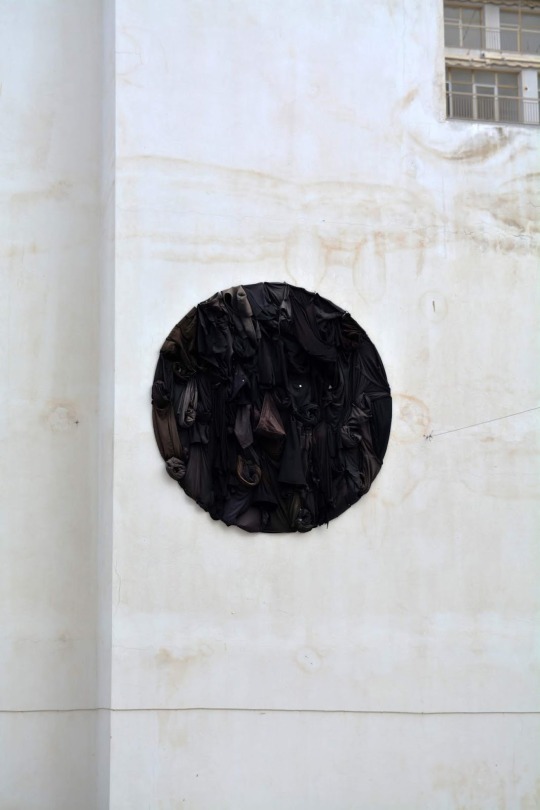




The urge to flee has never stopped...
"escapism", second hand clothes and nails, installation on the roof of The Project Gallery, part of the group exhibition "Man on the Moon"
Artist: Iakovos Volkov
Athens, Greece 2019
#greek street art#street art#street#art#iakovos volkov#nar arts#Athens#city#greece#downtown#urban culture#walls#outdoors#greek artists#public art#street art europe#installation#escape#freedom#γρεεκζ#γρεεκ ποστς
38 notes
·
View notes
Photo










Iakovos Volkov
Special Iakovos Volkov! Born in Russia, first in Thessaloniki and later in Athens begins to create using Spray. He quickly changes into other materials, making colorful installations, mostly in abandoned areas. Where are you from, how did you end up in Greece? Do you think your origin ·has affected your work? Have you studied anything related to visual arts? I come from Novorossiysk of Russia. I came with my mother and my brother after a three day trip in 1991. I don’t believe my origin has affected my work more than the place and the circumstances of life. I have a degree in thermohydraulics that’s irrelevant to the field of art but it may as well proved useful.
How did you decide to move from Thessaloniki to Athens? Most describe their first days at the center as chaotic. Fast pace of life terribly anxious people. Is there anything good about urban culture after all? In May 2014, I participated in the 'No Respect' exhibition at the Onassis cultural center. That’s where I met Cacao Rocks and Billy Gee who urged me to make an exhibition at the Sarri Gallery 12. I tried to stay in Athens two years before in 2012 but I didn’t socialized as I wished I had and thus I decided to return at my parents’ house. I already had a kind of experience so I wouldn’t say I was amazed, it’s just that the city is bigger than Thessaloniki comparatively to the town-plan and the population. I like the chaos and the buzz of the city. It has something that appeals to me.
Aesthetics in the urban public space used to be shaped by the huge products’ advertising campaigns. Now this has changed and the center is now full of tags, visuals, messages and more. How much does all this affect the everyday life of the citizen? if you asked me some years ago, I would say I don’t care that much. Now though I think It’s a little dull and somewhat tedious, especially because of the tags.
You started out with the traditional materials of a street artist but quickly changed into others. How did this transition go, and why do you do this? Is there a message you want to pass in the world? There was a period in my life that I faced some financial difficulties and I had to find other ways to create besides spray. So I started gathering various materials I was finding in factories, roads and next to rubbish bins. Creating and making things in general is the main reason I do what I do. I can’t stand the inactivity.
Where do you find so many clothes and how difficult is that? Describe us the process you follow for the placement of the articles of clothing. I had gathered the first clothes from Elliniko area next to the old airport where refugees used to stay. Some others next to rubbish bins and the rest from what people had left at the bazaar of Elaionas. When it comes to sculptures I have to buy some from the bazaar as I can’t often find children’s clothes on the streets and they can really be easily handled with the glue I use.
It seems like you give at second handed objects an other chance. Is it a conscious choice? How do the words you create are relative to the clothes themselves, fabrics, wire...? At the beginning this was somehow the goal but personally creating is more important. Along the way, I reduced the words but I never stopped using them. It’s the most direct way of expression. The place I visit more often has pushed me to create more abstract installations.
Your job is a category itself in Greece. Large, colorful installations in abandoned buildings. How easy was it to assimilate at the already existing Greek scene? I don’t know whether it could be relevant to the greek scene in general and I wasn’t intending to achieve something like that. It’s just something I feel the need to do which offers me satisfaction.
How difficult is it to create in public space? Have you experienced dangerous or even pleasant and funny incidents? Until now, I had no problems, especially because people wouldn’t mind me painting on an abandoned factory.
Collaborations that you have distinguished? Future business plans? I prefer working alone as I feel more concentrated. A collaboration that I could point out is Anabel Jujol at a festival in Essen, Germany.
In 10 years from now? Things are uncertain, but for the time being everything is going smoothly.
Follow Iakovos Volkov Website \ Blog \ Intagram
_
O ξεχωριστός Iakovos Volkov! Γεννημένος στην Ρωσία με πρώτη στάση στη Θεσσαλονίκη και αργότερα στην Αθήνα ξεκινάει να δημιουργεί με Spray. Πολύ γρήγορα περνάει σε άλλα υλικά πραγματοποιώντας πολύχρωμες εγκαταστάσεις σε εγκαταλελειμμένους κυρίως χώρους. Από που κατάγεσαι, πως βρέθηκες στην Ελλάδα; Πιστεύεις ότι η καταγωγή σου έχει επηρεάσει την δουλειά σου; Έχεις σπουδάσει κάτι σε σχέση με τα εικαστικά; Κατάγομαι από το Νοβοροσίσκ της Ρωσίας. Ήρθα με την μητέρα μου και τον αδερφό μετά από 3ημερο ταξίδι το 1991. Δεν πιστεύω ότι έχει επηρεάσει η καταγωγή μου την δουλειά μου, αλλά το μέρος και οι καταστάσεις της ζωής. Έχω ένα πτυχίο θερμοϋδραυλικού κάτι που είναι άσχετο με το χώρο της τέχνης αλλά μπορεί και όχι.
Πως πήρες την απόφαση να κατέβεις από την Θεσσαλονίκη στην Αθήνα; Οι περισσότεροι περιγράφουν τις πρώτες ώρες-μέρες στο κέντρο σοκαριστικές. Πολύ γρήγοροι ρυθμοί και φοβερά πιεσμένοι άνθρωποι. Υπάρχει κάτι καλό τελικά στην αστική κουλτούρα; Το Μάιο του 2014 είχα πάρει μέρος στην έκθεση ''No Respect'' στη Στέγη Γραμμάτων και Τεχνών. Εκεί γνώρισα τον Cacao Rocks και τον Billy Gee οι οποίοι με παρότρυναν να κάνω έκθεση στη Γκαλερί Sarri 12. Είχα δοκιμάσει να μείνω Αθήνα πριν 2 χρόνια το 2012 αλλά δεν δικτυώθηκα σωστά και αποφάσισα να γυρίσω πίσω στο πατρικό μου. Είχα ήδη μια εμπειρία, δεν μπορώ να πω ότι με σόκαρε κάτι, απλά η πόλη είναι πολεοδομικά και πληθυσ��ιακά μεγαλύτερη σε σχέση με την Θεσσαλονίκη. Μου αρέσει το χάος και η βαβούρα της πόλης. Έχει κάτι που με ελκύει.
Η αισθητική στον αστικό δημόσιο χώρο παλιά διαμορφώνονταν από τις τεράστιες καμπάνιες προϊόντων διαφημιστικών εταιριών. Τώρα αυτό έχει αλλάξει και το κέντρο πια είναι πάρα πολύ βαμμένο με tags, εικαστικά, μηνύματα κ.α. Πόσο επηρεάζει την καθημερινότητα του πολίτη όλο αυτό...; Προσωπικά, αν με ρωτούσες πριν κάποια χρόνια θα έλεγα ότι δεν με νοιάζει πολύ. Πλέον το βρίσκω ανιαρό σε κάποιο βαθμό καθώς και κάπως κουραστικό, ειδικά με τα tags.
Ξεκίνησες από τα παραδοσιακά υλικά ενός street artist αλλά γρήγορα πέρασες σε διαφορετικά. Πως έγινε η μετάβαση και για ποιον λόγο το κάνεις; Υπάρχει κάποιο μήνυμα που θέλεις περάσεις στον κόσμο; Υπήρχε περίοδος στην ζωή μου που αντιμετώπιζα κάποιες οικονομικές δυσκολίες και αναγκαστικά έπρεπε να βρω άλλους τρόπους να δημιουργώ εκτός από το σπρέι. Έτσι άρχισα να μαζεύω διάφορα υλικά που έβρισκα στα παρατημένα εργοστάσια, δρόμους και δίπλα σε κάδους σκουπιδιών. Το να δημιουργώ και να φτιάχνω γενικά πράγματα είναι ο κύριος λόγος που κάνω ότι κάνω. Δεν μπορώ να αντέξω για πολύ την απραξία.
Τόσα πολλά ρούχα που τα βρίσκεις και πόσο δύσκολο είναι αυτό; Περιέγραψε μας την διαδικασία που τα τοποθετείς στον χώρο. Τα πρώτα ρούχα τα είχα μαζέψει ��πό το Ελληνικό στο παλιό Αεροδρόμιο όπου έμειναν οι πρόσφυγες. Κάποια δίπλα από κάδους σκουπιδιών και τα υπόλοιπα όσα πετούσαν στο παζάρι του Ελαιώνα. Τώρα για να κάνω τα γλυπτά αναγκάζομαι να αγοράζω από το παζάρι διότι δεν βρίσκω συχνά έξω στους δρόμους ρούχα για μικρά παιδιά και με βολεύουν στο να τα χειρίζομαι εύκολα με την κόλλα.
Μοιάζει σαν να δίνεις στα πεταμένα αντικείμενα δεύτερη ευκαιρία. Είναι μια συνειδητή επιλογή; Πόσο σχετίζονται οι λέξεις που δημιουργείς με τα ίδια τα αντικείμενα; Στην αρχή αυτός ήταν κατά κάποιο τρόπο ο στόχος αλλά προσωπικά το να δημιουργώ είναι το πιο σημαντικό. Στην πορεία μείωσα τις λέξεις δίχως να σημαίνει πως τις παρατάω. Είναι από τους αμεσότερους τρόπους έκφρασης. Το μέρος που επισκέπτομαι πιο συχνά με ώθησε στο να κάνω πιο αφηρημένες εγκαταστάσεις.
Η δουλειά σου είναι μια κατηγορία από μόνη της στην Ελλάδα. Μεγάλες πολύχρωμες εγκαταστάσεις σε εγκαταλελειμμένα κτήρια. Πόσο εύκολο ήταν να αφομοιωθεί στην ήδη υπάρχων ελληνική σκηνή; Δεν γνωρίζω αν θα μπορούσε να σχετίζεται με την ελληνική σκηνή γενικότερα και δεν είχα ποτέ σκοπό να πετύχω κάτι τέτοιο. Είναι κάτι που νιώθω πως έχω ανάγκη να κάνω και μου προσφέρει ικανοποίηση.
Πόσο δύσκολο είναι να δημιουργείς στο δημόσιο χώρο; Σου έχουν τύχει άσχημα, επικίνδυνα περιστατικά ή και ευχάριστα, αστεία; Προς το παρόν δεν είχα προβλήματα κυρίως επειδή ο κόσμος δεν θα ασχοληθεί με ένα εγκαταλελειμμένο εργοστάσιο.
Συνεργασίες που έχεις ξεχωρίσει; Μελλοντικά επαγγελματικά σχέδια; Προτιμώ να δουλεύω μόνος γιατί νιώθω πιο συγκεντρωμένος. Μια συνεργασία που θα μπορούσα να ξεχωρίσω είναι η Anabel Jujol σε ένα φεστιβάλ στοΈσσεν της Γερμανίας.
Σε 10 χρόνια από τώρα; Όλα είναι αβέβαια αλλά προς το παρόν τα πάμε πολύ καλά.
#greek street art#greek street art - talks#nar#Iakovos Volkov#installation#colour#abondoned#Athens#city#greece#downtown#thessaloniki#urban#urban life#Greek Artist#outdoors#street art#art#γρεεκζ#γρεεκ ποστς
11 notes
·
View notes
Photo

Walls & Streets NYC meets Athens
Alibi Gallery and McCaig-Welles are pleased to present “Walls & Streets”, a mixed media group exhibition opening on Friday, October 12th from 6-10pm at Alibi Gallery in Athens, Greece. New York City, the birthplace of the graffiti movement in the 1970’s, saw the rise of legends such as Tats Cru, Lady Pink, Crash, Daze, and a host of others that became known as kings and queens of the graffiti world. Athens, often characterized as the “European capital of Street Art” became the ideal host for “Walls & Streets”, an international collaboration between Athen’s own Alibi Gallery and New York curator, Melissa McCaig-Welles. “Walls & Streets” focuses on a tightly curated selection of artists who are well known for their wall and street art practices in Athens, Greece, New York City and around the globe, alongside exciting work from the burgeoning street art scene of Athens . American artists Indie184, Logan Hicks, Shepard Fairey and Swoon are juxtaposed with Athens greats; artists include Cacao Rocks, Disgusto, Fikos, Iakovos Volkov, N_Grams, STMTS, and Vaggelis Choursogloue (Woozy). “Walls & Streets” integrates the works of renowned artists from New York City and Athens, creating a dialogue between these two distinct and diverse cultures touching onan array of unique styles, techniques, studies and philosophies. The exhibition explores street art as a universal language that exists without borders, despite the different characteristics and the uniqueness of each culture.” While conveying messages of dreams, fears, hopes and wishes, street art paves the way for genuine public diplomacy and expression, as it becomes a collective influencer and a facet for change around the world. Alibi Gallery, situated in the heart of Athens, is well known for showcasing established contemporary urban artists with a fundamental relationship with street art. Since opening their doors they have been showcasing recognized local artists and showcasing new talent entering the public sphere of street art. Melissa McCaig-Welles is an independent curator and founder of McCaig-Welles Gallery. She focuses on mid-career, cutting edge artists that have emerged from the urban aesthetics that figured prominently in cities around the U.S. leading up to the millennium. She is currently focusing on international street art in exhibitions she curates around the world.
Opening Reception: Friday, 12 October 6 - 7 pm Exhibition dates: 12 October- 12 December, 2018 Gallery Hours:: Daily 10:30 - 22:00 (closed on Tuesdays)
Fb Event
#greek street art#Athens#greece#art#Walls & Streets#art exhibition#Alibi Gallery#McCaig-Welles Gallery#γρεεκζ#γρεεκ ποστς
0 notes
Photo

Fresh on Greek Street Art-Talks. Read an interview with Iakovos Volkov
#greek street art#street art#street#art#visual art#lies#words#installation#wall art#iakovos volkov#nar#Athens#city#greece#downtown#urban#urban culture#outdoors#spray#paint#mural art#γρεεκζ#γρεεκ ποστς
106 notes
·
View notes
Photo

Special Iakovos Volkov! Born in Russia, first in Thessaloniki and later in Athens begins to create using Spray. He quickly changes into other materials, making colorful installations, mostly in abandoned areas.
#greek street art#street art#street#art#colorful#installation#nar#iakovos volkov#Athens#city#greece#downtown#urban#urban culture#outdoors#Greek Artist#abondoned#clothes#γρεεκ ποστς#γρεεκζ
75 notes
·
View notes
Photo

It seems like you give at second handed objects an other chance. Is it a conscious choice? How do the words you create are relative to the clothes themselves, fabrics, wire…?
At the beginning this was somehow the goal but personally creating is more important. Along the way, I reduced the words but I never stopped using them. It’s the most direct way of expression. The place I visit more often has pushed me to create more abstract installations.
Read More
#greek street art#street art#street#art#iakovos volkov#nar#rad#clothes#abondoned#Athens#city#greece#downtown#urban#urban culture#wall art#Greek Artist#γρεεκζ#γρεεκ ποστς
23 notes
·
View notes
Photo
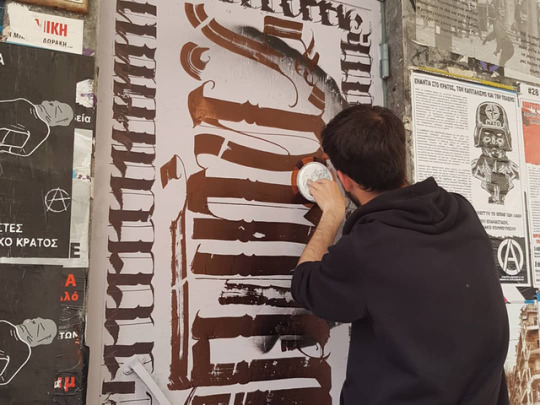


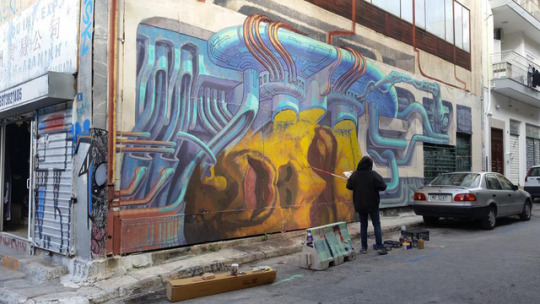
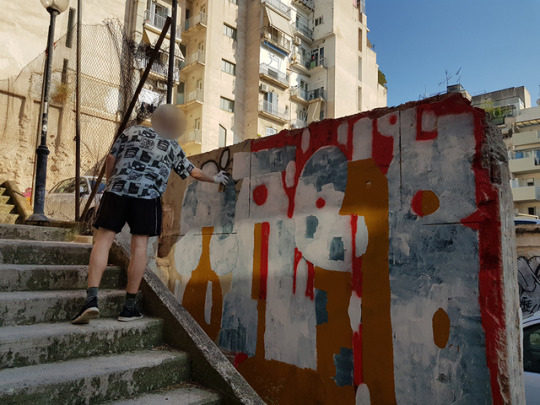
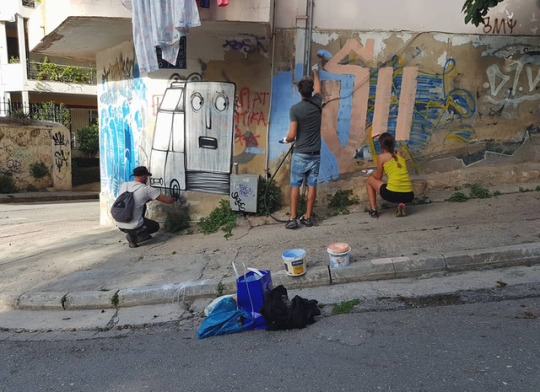
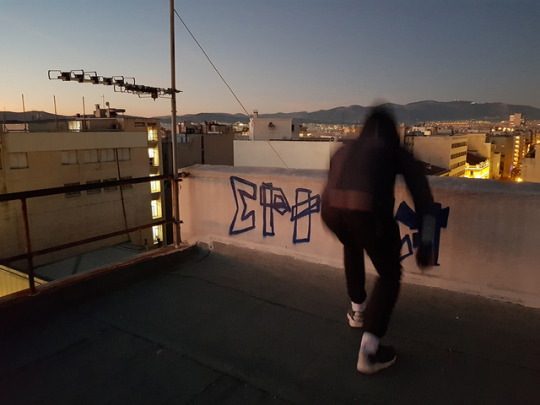
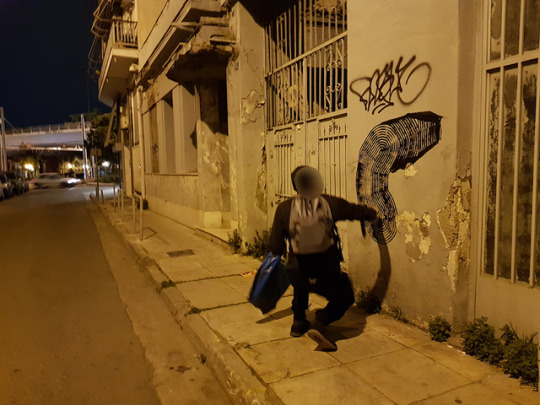
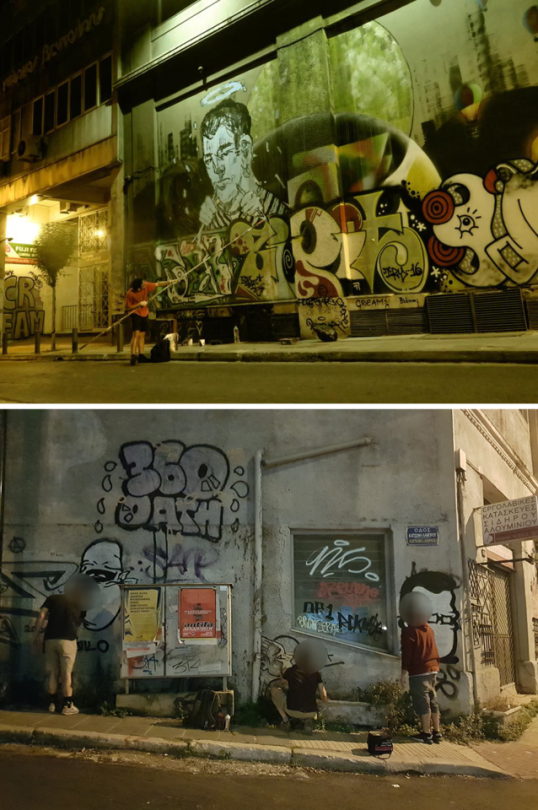

For the first time since we started interviews we talk to another blogger and not even a Greek one. A different kind of interview with the super-communicative Ivana who comes from Italy to explore among other European cities the urban culture of Athens. This month we discuss with her about her trips.
When did you come to Athens for the first time to explore the local culture and what led you to this decision? Is there a reputation of Athens abroad in relation to graffiti? My first small “urban art” trip in Athens had been in September 2017 and I chose this destination mainly because I received an invitation by a gallerist. I’d visited the city some years before, during an archeological tour of Greece, so I already had the chance to walk around as a tourist and to appreciate the beauty and the architecture of Athens, as well as a bit of street art. This second trip was mainly an overlook of the local street art and graffiti scene. It was interesting but very confusing at the same time. In Italy we know just a few names of Greek artists and crews so I couldn’t expect such a huge amount of writers and artists and so many different styles in the street, as well as I didn’t know that is a city full of contrasts and so much chaos. As a graffiti and urban art blogger and as a traveller, I immediately felt in love with Athens and people, so friendly and nice that right after I felt the need to go back to investigate and explore more and more, as much as possible. Nine months later I finally took the decision to move there.
Which were the first impressions from Athens and the people here? Since I’m from Rome I wasn’t surprised at all by traffic jams, noises and big distances, but I clearly remember that I was shocked by the amount of tags and graffiti in the streets, literally everywhere. I don’t think that you can find something like this, anywhere else in Europe. I felt like I was addicted by urban art and I used to walk for hours and hours taking photos, especially in Exarchia, Psirri and Metaxourgio, as I also used to spend some time watching graffiti on passing trains in Thissio. This crazy mix of street life, underground culture, decadence, chaos, creativity, freedom of expression and amazing graffiti styles was very exciting for me, and that was exactly what I was looking for in my previous trips. During that holiday, amongst one million graffiti pieces around the city, I was mainly impressed by the crews 420, NR4T, 381, Nda, Ofk and by some big old pieces by Amigos and Lifo.
Urban landscape, lives in the city. For some people living in the city is very stressful, while for some others it is liberating as the choices are quite many indeed. However, people seem to feel more and more lonely and get more and more isolated. What is your point of view on the way of living in major urban centers? When I moved to Athens I had the chance to fully enjoy the city for some months, I used to feel part of a big and well-connected community and a big cultural scene. I was enjoying hanging around and having fun with friends in parties, free events, underground life, graffiti actions, abandoned places’ explorations. Moreover I love how easy was to get in contact, meet and know artists and people in streets and cafè, especially in summertime. From the very first time this reminded me the typical lifestyle of an Italian city that I love, Palermo (Sicily). Unfortunately, living somewhere for a long time could be also a bit disappointing at some point. It took me months, or better, years to discover that beneath this artistic and social outward appearance there was a hidden reality full of all kind of problems, from isolation and loneliness to stress, unreliability and a general unstable mood and disorganisation. I could never say that the main reason is crisis, as the media would probably assert, but that’s for sure a dark side of the city that you can’t ignore or avoid.
What effects do you think the Arts have in our everyday life? Is Art in public space a natural aftermath? After two years living as a local in Athens I have to admit that I am used to the endless bombing of art (legal or illegal), vandalism in the street, and I like it. Apart from graffiti writing, I have the feeling that the “street art bubble”, or better, this current public art trend, which includes street art festivals and the business of “open-air street art museums” and street art tours, is about to explode. Honestly, I can’t wait for it.
What I mean is that both in Athens and in other European countries, there are good quality and well-organized events, but the majority are public initiatives of decoration as a form of urban “revitalization”, as if a mural could substitute for a retraining of an area. Most of these events “are just lark-mirrors and cunning and cheap solutions to limit underground scene and to hide or make inhabitants forget lack of interest and projects that could improve quality of life, in any possible way.
Moreover, nowadays a big street artist’s name or a big colourful mural are considered more important than quality and contents, and every day, everywhere, we have new improvised experts, curators, artists and even “Instagram posers”. Needless to say that this trend is not only used for political purposes but is also often connected with ignorance (just think of tourists and locals taking selfies in front of street art painted by artists who are not even known or mentioned), gentrifications and anti-graffiti campaigns.
As in every field, we should never forget where the whole street art movement comes from; if it weren’t for “vandalic” graffiti writing we’d never have the so called “urban art”, and would hypocrisy to deny it.
Creator and author of the blog “Urban Lives”. In which order did this happen? Did the book come first and then the blog followed or was it the other way round? What need meant to be covered by a project like that? My blog Urban Lives is online since 2016, while my book “Urban Lives - Discovering street art in Italy” had been published 2 years ago. The book can be considered as an in-depth essay, in fact only half of it includes articles from the blog. Because of this book and for many other reasons, as you also mentioned, I prefer to define Urban Lives an independent project (no sponsorships or business involved), because the term “blog” is quite reductive. Articles on street art and graffiti (Italian/English), travel reports, opinions, interviews with artists, photos of actions on Instagram are just a part of my activities. In these intense 4 years, I’ve also organized art residencies (such as the one in Rome with my friend and Greek artist Iakovos Volkov), travels and independent projects with artists, curator of walls/murals, graffiti jams and I’ve attended talks and conferences on street art in museums, universities and events all over Italy.
In short, Urban Lives is a big part of my life, it’s a diary, a passion, a lot of job of sacrifices, many trips, meetings with people, articles and stories, networking, new international friends, incredible situations and, here and there, even some dreams that came true. I even started to paint graffiti one year ago… but that’s another story!
You are actually writing stories about different cities, (Athens is one of them too) in which you have travelled and that are all somehow related to graffiti. Tell us a few things about the graffiti culture and the way you are perceiving it and experiencing it. Although I’ve been reading and travelling a lot, I can’t say that I have a good or even decent knowledge about graffiti in Europe and believe me, I am not modest, just objective. My school is mainly the street, that’s why I know a lot of things about Greek graffiti writing and I personally met many graffiti writers, including some old school train bombers and some very active ones. But it takes a lot of time to go deep and to understand a world that is so big, underground and complicated. What I’ve learned is that graffiti culture is another reality, with other rules, attitudes, needs and feelings. I needed a full immersion in this life and to personally experience actions, adrenaline, dangers and even tagging and painting to feel it. To be a writer can totally affects your life, either in a good or in a very bad way, and your perception of space and time.
Don’t you think that Art in the public space can become very intrusive, even annoying for some people? In my opinion, public art should be somehow connected with the environment, the urban landscape or the social community. But, to be honest, in the last years I am not that interested in public art, I am mainly focused on illegal street art (or street art for social causes) and, most of all, on graffiti writing. As we know, graffiti have to be intrusive, sometimes annoying, either in the street or on trains and metro. That’s part of the graffiti philosophy; it’s a challenge to be visible, it’s a challenge to be everywhere.
I guess we all have heard at some point that Athens is the new Berlin or that Athens is the European metropolis of Graffiti. Is this true ,in your opinion? Since you are travelling a lot and to different destinations each time.. In the last 3 years I’ve been several times in Berlin, spending a lot of time with local artists and graffiti writers, included 1up crew and Berlin Kidz. Both cities have a great graffiti scene and an important graffiti history, as well as a great subculture. Although some similarities are undeniable I wonder why everybody say that Athens is the new Berlin, as it could be its possible future evolution. At first, 3 years ago, I was also fallin in this “trap”. The paradox is that Athens is way behind Berlin and many other European cities, so I think it would be more correct to say that it’s just similar to the old Berlin, but probably with a stronger patriotic attitude and much more vandalism. No surprise that we have so many German writers coming to Athens nowadays, bombing everywhere. Of course, that doesn’t mean that Athens is not picking up, actually I think that the current effort of the city is impressive. But still, the cultural rebirth of the city is important but it’s not the main priority.
You are now living quite a long time here in Athens. Do you feel strongly connected to this city and its people and why? Definitely yes, here I feel home. I can’t imagine my life without Athens and its aesthetic, good vibes, good people. I’ve been living a lot of adventures, happy moments and amazing discoveries and I feel lucky and grateful for this big change in my life and for the whole experience, something that I’ll never forget. I am quite happy for the moment but I think that, as a thrilling chapter in the book of my life, this Greek experience might come to an end, maybe soon, maybe for a while.
In 10 years time? I hope that in 10 years I still will be a traveller and a reporter and a positive and energetic person full of curiosity, passion and interests. Of course I also hope that, somehow, I’ll be connected with the underground culture. Who knows, maybe one day I will quit writing on graffiti and I will be a proper graffiti writer ihihih... Life is unpredictable (especially mine), we will see!
Thank you very much for this interview, it’s been a great pleasure for me!
Artworks by: Aner, Chius, Barba Dee, Perk Up, Friend, c0in, Conjoined movement, RTMone, Chus, Kasp (OFK), Mota, MrFijodor, Sora, Pyc, Skirl, Wild Drawing, Weed, 1UP
Follow Urban Lives Blog \ Instagram \ Fb Page \ Twitter
_
Για πρώτη φορά, από την στιγμή που ξεκινήσαμε τις συνεντεύξεις μιλάμε με μία άλλη blogger και μάλιστα όχι Eλληνίδα. Μία διαφορετική συνέντευξη με την σούπερ επικοινωνιακή Ivana η οποία έρχεται από την Ιταλία για να εξερευνήσει μεταξύ άλλων ευρωπαϊκών πόλεων και την αστική κουλτούρα της Αθήνας. Αυτό τον μήνα μιλάμε μαζί της για τις διαδρομές της.
Πότε ήρθες πρώτη φορά στην Αθήνα για να εξερευνήσεις την αστική κουλτούρα και τι σε οδήγησε σε αυτή την απόφαση; Υπάρχει κάποια φήμη για την Αθήνα στο εξωτερικό σε σχέση με το γκράφιτι; Το πρώτο μου μικρό ταξίδι «αστικής τέχνης» στην Αθήνα ήταν τον Σεπτέμβριο 2017 και διάλεξα αυτόν τον προορισμό κυρίως επειδή έλαβα πρόσκληση από έναν γκαλερίστα. Είχα επισκεφτεί την πόλη πριν κάτι χρόνια, κατά τη διάρκεια μιας αρχαιολογικής εκδρομής στην Ελλάδα, οπότε μου είχε δοθεί ήδη η ευκαιρία να τριγυρίσω σαν τουρίστας και να εκτιμήσω την ομορφιά και την αρχιτεκτονική της Αθήνας, όπως επίσης και μέρος της τέχνης του δρόμου. Αυτό το δεύτερο ταξίδι ήταν κυρίως μια παρατήρηση της τοπικής τέχνης του δρόμου και της γκράφιτι σκηνής. Ήταν ενδιαφέρον αλλά συνάμα δημιουργούσε σύγχυση. Στην Ιταλία ξέρουμε μόνο μερικά ονόματα ελλήνων καλλιτεχνών και ομάδων, οπότε δε περίμενα τόσο μεγάλο ποσό από writers και καλλιτέχνες και τόσα διαφορετικά στυλ στους δρόμος, όπως επίσης δεν ήξερα ότι ήταν μία πόλη γεμάτη αντιθέσεις και τόσο πολύ χάος. Ως μία blogger αστικής τέχνης και γκράφιτι όπως επίσης και ταξιδιώτισσα, αμέσως ένιωσα ερωτευμένη με την Αθήνα και τους ανθρ��πους, τόσο φιλικοί, τόσο καλοί που κατευθείαν ένιωσα την ανάγκη να γυρίσω πίσω να διερευνήσω και να εξετάσω όλο και περισσότερο, όσα περισσότερα μπορούσα. Εννιά μήνες αργότερα πήρα επιτέλους την απόφαση να μετακινηθώ εκεί.
Ποιες ήταν οι πρώτες σου εντυπώσεις για την Αθήνα και για τους ανθρώπους εκεί; Καθώς είμαι από τη Ρώμη δεν εξεπλάγην από την κυκλοφοριακή κίνηση, τους θορύβους και τις μεγάλες αποστάσεις, αλλά θυμάμαι ξεκάθαρα ότι είχα σοκαριστεί από το ποσοστό των ταγκς και των γκραφιτι στους δρόμους, κυριολεκτικά παντού. Δε νομίζω ότι μπορείς αν βρεις κάτι τέτοιο πουθενά αλλού στην Ευρώπη. Ένιωσα σα να ήμουν εθισμένη στην αστική τέχνη και συνήθιζα να περπατάω για ώρες και ώρες βγάζοντας φωτογραφίες , ειδικά στα Εξάρχεια, Ψυρρή, Μεταξουργείο, ¨όπως επίσης συνήθιζα να περνάω χρόνο βλέποντας τα γκράφιτι στα τραίνα που περνούσαν στο Θησείο. Αυτή η τρελή μείξη της ζωής στον δρόμο, της υπόγειας κουλτούρας, της παρακμής, τους χάους, της δημιουργικότητας, της ελευθερίας της έκφρασης και των τρομερών γκράφιτι στυλ ήταν πολύ συναρπαστική για εμένα και αυτό ακριβώς που αναζητούσα στα προηγούμενα ταξίδια μου. Κατά τη διάρκεια εκείνων των διακοπών μεταξύ εκατομμυρίων γκράφιτι γύρω στην πόλη, ήμουν κυρίως ενθουσιασμένη με τις ομάδες 420, NR4T, 381,Nda, Ofk Και μερικά παλαιότερα μεγάλα κομμάτια από Amigos και Lifo.
Το αστικό τοπίο ζει μέσα στην πόλη. Για κάποιους ανθρώπους που ζουν στην πόλη είναι πολύ αγχωτικό, ενώ για κάποιους άλλους είναι απελευθερωτικό καθώς οι επιλογές είναι πράγματι πάρα πολλές. Παρολαυτά, οι άνθρωποι φαίνεται να νιώθουν πιο μόνοι και να απομονώνονται περισσότερο. Ποιά είναι η γνώμη σου για τον τρόπο ζωής στα μεγάλα αστικά κέντρα; Όταν μετακινήθηκα στην Αθήνα είχα την ευκαιρία να ευχαριστηθώ πλήρως την πόλη για κάποιους μήνες, ένιωθα μέλος μιας μεγάλης και ωραία συνδεδεμένης κοινότητας και μιας μεγάλης πολιτιστικής σκηνής. Διασκέδαζα να κάνω βόλτες και να περνάω όμορφα με ανθρώπους σε πάρτυ, ανοιχτές εκδηλώσεις, υπόγεια ζωή, γκράφιτι δράσεις, εξερευνήσεις εγκαταλελειμμένων χώρων. Επιπλέον πρέπει να προσθέσω πόσο εύκολο ήταν να έρθω σε επαφή, να συναντήσω και να γνωρίσω καλλιτέχνες και ανθρώπους στους δρόμους και στα καφέ, ειδικά την περίοδο του καλοκαιριού. Από την πρώτη στιγμή αυτό μου θύμισε τον τυπικό τρόπο ζωής μιας ιταλικής πόλης που αγαπάω το Παλέρμο (Σικελία). Δυστυχώς το να μένεις κάπου για μεγάλο χρονικό διάστημα μπορεί να γίνει και λίγο απογοητευτικό σε ένα σημείο.
Μου πήρε μήνες ή καλύτερα χρόνια να ανακαλύψω ότι πίσω από την καλλιτεχνική και κοινωνική εξωστρεφή εμφάνιση ήταν κρυμμένη μια πραγματικότητα γεμάτη όλων των ειδών τα προβλήματα, από απομόνωση και μοναξιά, μέχρι άγχος, αναξιοπιστία και μια γενική διάθεση αστάθειας και ανοργανωσιάς. Δε θα μπορούσα να πω ποτέ ότι ο βασικός λόγος είναι η κρίση, όπως θα υποστήριζαν πιθανότατα τα μέσα ενημέρωσης, αλλά είναι σίγουρα μια σκοτεινή πλευρά της πόλης που δε μπορείς να αγνοήσεις ή να αποφύγεις.
Τι συνέπειες πιστεύεις ότι έχουν οι τέχνες στην καθημερινή μας ζωή; Είναι η τέχνη στο δημόσιο χώρο ένα φυσικό επακόλουθο; Μετά από δύο χρόνια που ζω ως ντόπια στην Αθήνα πρέπει να παραδεχτώ ότι είμαι συνηθισμένη σε ατελείωτο bombing τέχνης (νόμιμο ή παράνομο), βανδαλισμό στο δρόμο και μου αρέσει. Εκτός από το γκράφιτι writing, έχω την εντύπωση ότι η «φούσκα της τέχνης του δρόμου» ή καλύτερα η τρέχουσα τάση της δημόσιας τέχνης η οποία περιλαμβάνει φεστιβαλ τέχνης του δρόμου και την υπόθεση των υπαίθριων μουσείων τέχνης του δρόμου και περιηγήσεις της τέχνης του δρόμου είναι έτοιμη να εκραγεί. Ειλικρινά δε μπορώ να περιμένω. Αυτό που εννοώ είναι ότι και στην Αθήνα και σε άλλες ευρωπαϊκές χώρες υπάρχουν καλής ποιότητας και καλά οργανωμένες εκδηλώσεις, αλλά στην πλειοψηφία είναι δημόσιες πρωτοβουλίες διακόσμησης σαν μια μορφή αστικής «αναζωογόνησης», λες μία τοιχογραφία θα μπορούσε να αντικαταστήσει την επανεκπαίδευση μιας περιοχής. Οι περισσότερες από αυτές τις εκδηλώσεις «είναι απλά πονηρές και φθηνές λύσεις για να περιορίσουν την υπόγεια σκηνή και να κρύψουν ή να κάνουν τους κατοίκους και να ξεχάσουν την έλλειψη ενδιαφέροντός τους και εκδηλώσεις που θα μπορούσαν να βελτιώσουν την ποιότητα ζωής με κάθε δυνατό τρόπο»
Επιπλέον, αυτές τις μέρες ένα μεγάλο όνομα καλλιτέχνη του δρόμου ή μια μεγάλη τοιχογραφία θεωρούνται πιο σημαντικά απ’ ο, τι η ποιότητα και το περιεχόμενο και κάθε μέρα, παντού, έχουμε νέους εξελιγμένους ειδικούς, επιμελητές, καλλιτέχνες, ακόμα και “instagram posers”. Αχρείαστο να πω ότι αυτή η τάση δε χρησιμοποιείται μόνο για πολιτικούς σκοπούς, αλλά επίσης είναι συχνά συνδεδεμένη με την άγνοια ( απλά σκεφτείτε τους τουρίστες και τους ντόπιους που βγάζουν selfies μπροστά από τέχνη του δρόμου ζωγραφισμένη από καλλιτέχνες που δεν γνωρίζουν καν, ούτε αναφέρουν), γενικεύσεις και αντι-γκράφιτι καμπάνιες.
Όπως σε κάθε τομέα, δε πρέπει ποτέ να ξεχνάμε από που προέρχεται όλο το κίνημα της τέχνης του δρόμου, α�� δεν ήταν το βανδαλιστικό γκράφιτι writing δε θα είχαμε ποτέ αυτό που ονομάζουμε «αστική τέχνη» και θα ήταν υποκρισία να το αρνηθούμε.
Δημιουργός και συγγραφέας του μπλογκ “Urban Lives”. Με ποια σειρά έγινε αυτό; Ήρθε πρώτα το βιβλίο και μετά ακολούθησε το μπλογκ ή το αντίθετο; Τι ανάγκη χρειαζόταν κάλυψη από ένα πρότζεκτ σαν αυτό; Το blog μου Urban Lives είναι online από το 2016, ενώ το βιβλίο μου "UrbanLives - Ανακαλύπτοντας την τέχνη του δρόμου στην Ιταλία" είχε δημοσιευθεί πριν από 2 χρόνια. Το βιβλίο μπορεί να θεωρηθεί ως ένα σε βάθος δοκίμιο, στην πραγματικότητα μόνο το ήμισυ περιλαμβάνει άρθρα από το blog. Λόγω αυτού του βιβλίου και για πολλούς άλλους λόγους, όπως ανέφερες, προτιμώ να ορίζω το Urban Lives ως ένα ανεξάρτητο project (χωρίς να περιλαμβάνονται χορηγίες ή επιχειρήσεις), επειδή ο όρος "blog" είναι αρκετά απλός. Άρθρα σχετικά με την τέχνη του δρόμου και τα γκράφιτι (ιταλικά / αγγλικά), αναφορές ταξιδιών, απόψεις, συνεντεύξεις με καλλιτέχνες, φωτογραφίες από δράσεις στο Instagram είναι μόνο μέρος των δραστηριοτήτων μου. Σε αυτά τα έντονα 4 χρόνια, διοργάνωσα επίσης χώρους τέχνης (όπως στη Ρώμη με τον φίλο μου και τον Iakovos Volkov), ταξίδια και ανεξάρτητα έργα με καλλιτέχνες, επιμέλειες τοίχων / τοιχογραφιών, γκράφιτι και έχω παρακολουθήσει συζητήσεις και συνέδρια για την τέχνη του δρόμου σε μουσεία, πανεπιστήμια και εκδηλώσεις σε όλη την Ιταλία.Με λίγα λόγια, το Urban Lives είναι ένα μεγάλο μέρος της ζωής μου, είναι ένα ημερολόγιο, πάθος, πολλή δουλειά θυσιών, πολλά ταξίδια, συναντήσεις με ανθρώπους, άρθρα και ιστορίες, δικτύωση, νέοι διεθνείς φίλοι, απίστευτες καταστάσεις εδώ και εκεί , ακόμα και μερικά όνειρα που έγιναν πραγματικότητα. Άρχισα να ζωγραφίζω γκράφιτι πριν από ένα χρόνο ... αλλά αυτή είναι μια άλλη ιστορία! Γράφεις ιστορίες για διαφορετικές πόλεις ( η Αθήνα είναι μία από αυτές επίσης) στις οποίες έχεις ταξιδέψει και που με κάποιο τρόπο σχετίζονται με το γκράφιτι. Πες μας μερικά πράγματα για την γκράφιτι κουλτούρα και τον τρόπο που την προσλαμβάνεις και την βιώνεις. Παρόλο που διαβάζω και ταξιδεύω πολύ, δεν μπορώ να πω ότι έχω καλή ή ακόμη και αξιοπρεπή γνώση σχετικά με το γκράφιτι στην Ευρώπη και πιστέψτε με, δεν το λέω με μετριοφροσύνη, είμαι απλώς αντικειμενική. Το σχολείο μου είναι κυρίως ο δρόμος, γι 'αυτό και γνωρίζω πολλά πράγματα για το γκράφιτι writing στην Ελλάδα και προσωπικά συναντήθηκα με πολλούς γκράφιτι writers, συμπεριλαμβανομένων μερικών old school bombers τρένων και μερικούς πολύ δραστήριους. Χρειάζεται όμως πολύς χρόνος για να πας βαθιά και να κατανοήσεις έναν κόσμο που είναι τόσο μεγάλος, υπόγειος και περίπλοκος. Αυτό που έχω μάθει είναι ότι η γκράφιτι κουλτούρα είναι μια άλλη πραγματικότητα, με άλλους κανόνες, συμπεριφορές, ανάγκες και συναισθήματα. Χρειαζόμουν μια πλήρη βύθιση σε αυτή τη ζωή και προσωπικά να βιώσω δράσεις, αδρεναλίνη, κινδύνους και ακόμη και να κάνω tagging και να ζωγραφίσω για να την νιώσω. Το να είσαι writer μπορεί να επηρεάσει εντελώς τη ζωή σου, είτε με καλό είτε με πολύ κακό τρόπο, και την αντίληψή σου για το χώρο και το χρόνο.
Δεν πιστεύεις ότι η τέχνη στον δημόσιο χώρο μπορεί να γίνει πολύ επεμβατική, ακόμα και ενοχλητική για πολλούς ανθρώπους; Κατά τη γνώμη μου, η δημόσια τέχνη πρέπει να συνδέεται κατά κάποιο τρόπο με το περιβάλλον, το αστικό τοπίο ή την κοινωνία. Αλλά, για να είμαι ειλικρινής, τα τελευταία χρόνια δεν ενδιαφέρομαι τόσο για τη δημόσια τέχνη, εστιάζω κυρίως στην παράνομη τέχνη του δρόμου (ή την τέχνη του δρόμου για κοινωνικούς σκοπούς) και πάνω απ 'όλα, στο graffiti writing. Όπως γνωρίζουμε, τα γκράφιτι πρέπει να είναι επεμβατικά , μερικές φορές ενοχλητικά, είτε στο δρόμο είτε σε τρένα και μετρό. Αυτό είναι μέρος της φιλοσοφίας του γκράφιτι: είναι μια πρόκληση να είναι ορατό, είναι μια πρόκληση να είναι παντού.
Φαντάζομαι όλη έχουμε ακούσει σε κάποια στιγμή ότι η Αθληνα είναι η ευρωπαϊκή μητρόπολη του γκράφιτι. Είναι αυτό αλήθεια κατά τη γνώμη σου; Αφού ταξιδεύεις πολύ και σε διαφορετικούς προορισμούς κάθε φορά… Τα τελευταία 3 χρόνια βρέθηκα αρκετές φορές στο Βερολίνο, περνόντας πολύ χρόνο με τοπικούς καλλιτέχνες και γκράφιτι writers, συμπεριλαμβανομένης της ομάδας 1up και τους Berlin Kidz. Και οι δύο πόλεις έχουν μια μεγάλη σκηνή γκράφιτι και μια σημαντική ιστορία γκράφιτι, καθώς και μια μεγάλη υποκουλτούρα. Αν και κάποιες ομοιότητες είναι αναμφισβήτητες, αναρωτιέμαι γιατί όλοι λένε ότι η Αθήνα είναι το νέο Βερολίνο, σαν να μπορούσε να είναι η πιθανή μελλοντική εξέλιξή του. Στην αρχή, πριν από 3 χρόνια, έπεφτα και σε αυτήν τη "παγίδα". Το παράδοξο είναι ότι η Αθήνα είναι πολύ πιο πίσω από το Βερολίνο και από πολλές άλλες ευρωπαϊκές πόλεις, επομένως νομίζω ότι θα ήταν πιο σωστό να πούμε ότι μοιάζει ακριβώς με το παλιό Βερολίνο, αλλά μάλλον με μια ισχυρότερη πατριωτική στάση και πολύ περισσότερο βανδαλισμό. Δεν προκαλεί έκπληξη ότι έχουμε τόσους πολλούς Γερμανούς writers που έρχονται στην Αθήνα σήμερα, κάνοντας bombing παντού.Φυσικά, αυτό δεν σημαίνει ότι η Αθήνα δεν είναι ενεργή, για την ακρίβεια πιστεύω ότι η σημερινή προσπάθεια της πόλης είναι εντυπωσιακή. Όμως, η πολιτιστική αναγέννηση της πόλης είναι σημαντική αλλά δεν αποτελεί την κύρια προτεραιότητα.
Ζεις τώρα αρκετό καιρό εδώ στην Αθήνα. Νιώθεις ��τενά συνδεδεμένη με αυτή την πόλη και τους κατοίκους της και γιατί; Σίγουρα ναι, εδώ αισθάνομαι σπίτι μου. Δεν μπορώ να φανταστώ τη ζωή μου χωρίς την Αθήνα και την αισθητική της, ωραία ενέργεια, καλοί άνθρωποι. Έχω ζήσει πολλές περιπέτειες, ευτυχισμένες στιγμές και εκπληκτικές ανακαλύψεις και αισθάνομαι τυχερή και ευγνώμων γι 'αυτή τη μεγάλη αλλαγή στη ζωή μου και για όλη την εμπειρία, κάτι που δεν θα ξεχάσω ποτέ. Είμαι πολύ χαρούμενη αυτή τη στιγμή, αλλά νομίζω ότι, σαν ένα συναρπαστικό κεφάλαιο στο βιβλίο της ζωής μου, αυτή η ελληνική εμπειρία θα μπορούσε να τελειώσει, ίσως σύντομα, ίσως για λίγο.
Σε 10 χρόνια από τώρα; Ελπίζω ότι σε 10 χρόνια θα συνεχίσω να είμαι ταξιδιώτισσα και δημοσιογράφος και θετικός και δραστήριος άνθρωπος γεμάτη περιέργεια, πάθος και ενδιαφέροντα. Φυσικά και ελπίζω ότι με κάποιο τρόπο θα είμαι συνδεδεμένη με την υπόγεια κουλτούρα. Ποιος ξέρει, ίσως μια μέρα να σταματήσω να γράφω για το γκράφιτι writing και να γίνω μία σωστή γκράφιτ writer χιχιχιχι ... Η ζωή είναι απρόβλεπτη (ειδικά η δική μου), θα δούμε!
Σας ευχαριστώ πολύ για αυτή τη συνέντευξη, ήταν μεγάλη χαρά για μένα!
#greek street art#street art#street#art#graffiti#spray#paint#Draw#urban lives#Athens#city#greece#downtown#urban culture#walls#outdoors#bombing#public art#street art europe#γρεεκ ποστς#γρεεκζ
4 notes
·
View notes
Photo

1000 Συγνώμη
Iakovos Volkov
#greek street art#street art#street#art#iakovos volkov#nar arts#abondoned#sorry#greece#urban culture#public art#street art europe#mural art#wall art#outdoors#greek artists#γρεεκζ#γρεεκ ποστς
280 notes
·
View notes
Photo

Iakovos Volkov - "I am still here"
The art space Alibi (Sarri 12), kindly presents the new work of Iakovos Volkov, in the solo exhibition “I am still here”, which will take place from March 8 through May 8, 2018.
Fb Event
0 notes